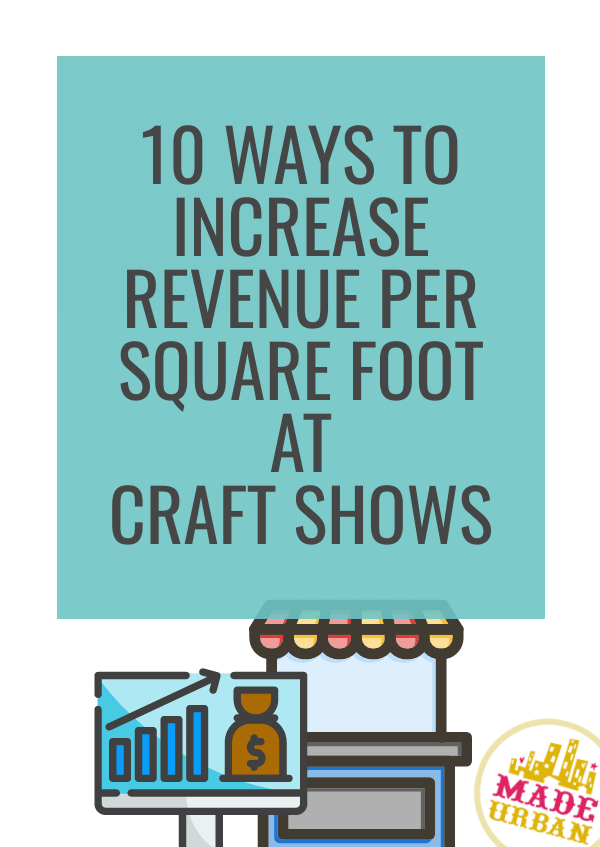10 Ways To Increase Revenue per Square Foot at Craft Shows
Every vendor wants to make as much money as possible at each event. But to increase your revenue, you have to be strategic. It’s not enough to show up with the same products/display/sales strategy and hope for the best.
Calculating your revenue per square foot can help you find areas of opportunity.
To determine your revenue per square foot:
Divide the total revenue by square foot
For example, if I sold $500 worth of products and had a 6’ x 2.5’ table, that’s 15 square feet of sales space.
500 divided by 15 = 33.33
My revenue per square foot is $33.33
Once you know that number, you can work on increasing it. Here are 9 ways to increase your revenue per square foot.
1) Focus on best sellers
This one may seem obvious but a lot of vendors have so much variety, they don’t know what their best sellers are.
When I started selling at craft shows, I had several types of products (e.g. pyjamas, bags, aprons, pillows, mittens, etc.). But even once I started focusing on just bags, I still had a lot of variation.
Every bag was different (different material, style, size, etc.).
I only had one of each bag, so it was impossible to find sales patterns.
When I refined my selection and focused on just a few styles of bags, it was easy to see which style I sold the most of (my weekend bag). With each craft show, I made more and more of my weekend bag and dedicated more display space to it.
Be sure you’re tracking your sales and can find patterns.
>> Which type of product do you sell the most of?
>> For each type of product, which color/material/size/scent/etc. sells the most?
As you track your sales stats, refine your display to give more space to your best sellers.
2) Smaller footprint items
The basic idea is that you can fit more small products into a space than large products.
For example, I can fit 20 tote bags into a space on my table or 4 cosmetic bags.
Tote bags = $25/each
Cosmetic bags = $30/each
Revenue potential:
Tote bags = $500
Cosmetic bags = $120
Although the tote bags fold up and take up less display space, I also have to compare that to their sales stats and profit margins.
Filling a space with 50 small items that have low sales and profit margins won’t be beneficial.
Filling a space with a best-selling product with high profit margins and a small footprint is a winning formula.
3) Go vertical
Adding fixtures to your table or booth that allow you to stretch your display space up will allow you to fit more products into your display and potentially increase your revenue per square foot.
Raising your display to eye level can also help boost sales.
“Eye level is buy level” because it’s where shoppers tend to look first. Products displayed here are more likely to catch shoppers’ attention, draw them in, and get them to interact with your products.
4) Display less
It’s important not to try and squeeze as many products as possible into your space, as that can have the opposite effect. A crammed space can lower the perceived value of your products.
Try keeping more stock behind your table and replenishing as items sell.
This creates a sense of urgency with shoppers because seeing just one or two of a product can make them believe that if they don’t buy now, it could sell out.
Fewer products also allow for more negative space, which can make products seem more expensive. And when shoppers think your products are more valuable than their prices, they’re more likely to buy.
5) Bundle items
Try bundling items that work together into tightly grouped displays or packages. Not only will this help you fit more into your space, but it will also increase your value per transaction (instead of a shopper buying one item, they buy multiple).
For example, instead of displaying a tote bag in one section, the matching cosmetic bag in another section, and the small case in another section, I would group them in a tight composition.
Instead of displaying just one tote bag in the section, with a revenue potential of $50, I can fit two other items in and increase it to $90.
6) Make use of zones
As this article explains, retailers break their stores into zones to work with common shopping habits. These zones can be applied at a craft show, even if you have a 6-foot table.
Displaying the right products in the right zones will encourage more people to buy.
>> Zone 1 should display showstoppers that get more people to stop at your table/booth.
>> Zone 2 should house the majority of your stock, and that stock should be proven winners (i.e. best sellers).
>> Zone 3 is where the shopping experience comes to an end, and shoppers either buy or leave with marketing material so they can buy in the future. This area should display smaller, lower-priced items that are easy to add to an existing purchase and will increase your value per transaction.
Check out this article for more information on zones: Craft Show Table Layout Tips
7) Increase conversion rates
It’s one thing to create a beautiful display that attracts lots of shoppers, but none of that matters if those shoppers leave your space without buying.
Track stats that help you calculate conversion rates.
>> Find out from the event organizer how many people attended the event.
>> Of those people, how many of them stopped at your table/booth?
>> Of the people who stopped at your table/booth, how many purchased?
Divide the number of people who took a desired action (e.g. purchased) by the total number of people (who did and did not take the action). Then multiply that number by 100 to get a percentage.
For example, if the event had 500 shoppers and 50 of them stopped at my table, my display’s conversion rate would be 10% (my display converted 10% of the craft show shoppers into my shoppers).
If 50 shoppers stopped at my booth and 15 of them purchased, my sales conversion rate would be 30%.
Constantly look for ways to increase that conversion rate.
Watch shoppers to see if you can determine where you might have lost the sale.
For example, do they walk away once they see prices? You may need to improve branding, packaging, or presentation to increase the perceived value of your products so shoppers believe your prices are fair.
8) Run event-specific promotions
If your profit margins allow, run a different promotion for each event (e.g. “this craft show only, cosmetic bags are 15% off”). That can help move more of a particular product and create urgency for shoppers.
If they know they must buy now to get the deal, they’re more likely to act rather than think about it and buy after the event.
9) Cut products
It’s important to be a little ruthless when it comes to which products deserve a spot in your display.
I had one bag that was hand-knitted with a wooden handle I had carved. Almost every craft show shopper picked it up and would “ooh” and “awe” over it. But it never sold. I kept giving it space on my table, even though it didn’t deserve it.
Make sure you’re tracking important stats (7 Stats to Track at Craft Shows (to improve sales)) and adjusting your production and display accordingly.
You may love making a certain product, and shoppers may love looking at it, but if it doesn’t sell, it’s not worth your time, money, or space.
10) Favour high profit margins
You don’t just want to increase the revenue your craft show table produces; you also want to be sure there are profits left from that revenue.
If you sell $500 worth of products but $250 of that covers material and production costs and another $200 covers table fees, travel and food costs, display costs, wages for setting up/selling/packing up, etc., you only have an extra $50 in your pocket after paying back your expenses and wages.
The more you can reduce costs and increase profits, the better.
If you have best sellers that also have higher profit margins, dedicate more display space to those items.
You can also look for ways to reduce your production and overhead costs so less of your revenue goes to paying those costs and wages.
For example, you might:
- Find materials at cheaper prices
- Streamline production so it takes you less time to make each item
- Park further away from the venue to save on parking fees
- Streamline your setup and takedown so you’re spending less time working before and after selling hours
- Etc.
Review
After each craft show, determine your total revenue per square foot. From there, you can use sales stats to determine which products produced the most revenue.
If you can, try to roughly calculate how many square feet (or inches) a product has in your display so you know which products sold best for their footprint.
You may find that one product may not have necessarily produced the most sales, but it did produce the most revenue for the square feet it had in your display.
Slowly dedicate more space to the products you sold more of and use the tips above to try and increase your revenue per square foot.


Hey, I’m Erin 🙂 I write about small business and craft show techniques I’ve learned from being a small business owner for almost 2 decades, selling at dozens of craft shows, and earning a diploma in Visual Communication Design. I hope you find my advice helpful!
